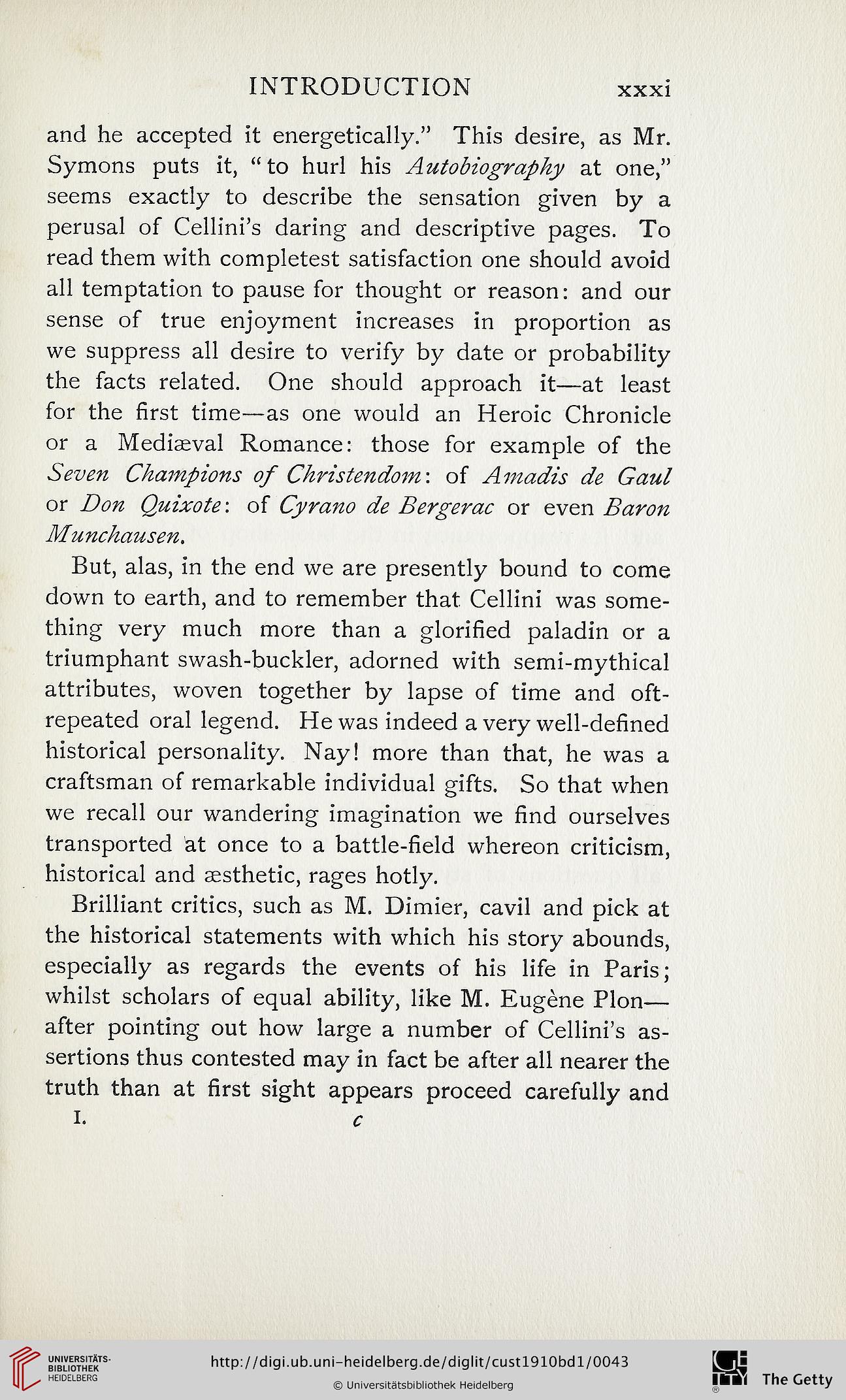INTRODUCTION
XXXI
and he accepted it energetically." This desire, as Mr.
Symons puts it, "to hurl his H 22^32^^^/^ at one,"
seems exactly to describe the sensation given by a
perusal of Cellini's daring and descriptive pages. To
read them with completest satisfaction one should avoid
all temptation to pause for thought or reason: and our
sense of true enjoyment increases in proportion as
we suppress all desire to verify by date or probability
the facts related. One should approach it—at least
for the first time—as one would an Heroic Chronicle
or a Mediaeval Romance: those for example of the
(/%<%772^2<?72.f <?/* (l^r2y^72<^7772 : of H J <3^
or Z?<3?2 of <3^ or even Z?<3?V7z
3^2272^2222^72.
But, alas, in the end we are presently bound to come
down to earth, and to remember that Cellini was some-
thing very much more than a glorified paladin or a
triumphant swash-buckler, adorned with semi-mythical
attributes, woven together by lapse of time and oft-
repeated oral legend. He was indeed a very well-defined
historical personality. Nay! more than that, he was a
craftsman of remarkable individual gifts. So that when
we recall our wandering imagination we find ourselves
transported at once to a battle-field whereon criticism,
historical and aesthetic, rages hotly.
Brilliant critics, such as M. Dimier, cavil and pick at
the historical statements with which his story abounds,
especially as regards the events of his life in Paris;
whilst scholars of equal ability, like M. Eugene Plon—
after pointing out how large a number of Cellini's as-
sertions thus contested may in fact be after all nearer the
truth than at first sight appears proceed carefully and
1. <r
XXXI
and he accepted it energetically." This desire, as Mr.
Symons puts it, "to hurl his H 22^32^^^/^ at one,"
seems exactly to describe the sensation given by a
perusal of Cellini's daring and descriptive pages. To
read them with completest satisfaction one should avoid
all temptation to pause for thought or reason: and our
sense of true enjoyment increases in proportion as
we suppress all desire to verify by date or probability
the facts related. One should approach it—at least
for the first time—as one would an Heroic Chronicle
or a Mediaeval Romance: those for example of the
(/%<%772^2<?72.f <?/* (l^r2y^72<^7772 : of H J <3^
or Z?<3?2 of <3^ or even Z?<3?V7z
3^2272^2222^72.
But, alas, in the end we are presently bound to come
down to earth, and to remember that Cellini was some-
thing very much more than a glorified paladin or a
triumphant swash-buckler, adorned with semi-mythical
attributes, woven together by lapse of time and oft-
repeated oral legend. He was indeed a very well-defined
historical personality. Nay! more than that, he was a
craftsman of remarkable individual gifts. So that when
we recall our wandering imagination we find ourselves
transported at once to a battle-field whereon criticism,
historical and aesthetic, rages hotly.
Brilliant critics, such as M. Dimier, cavil and pick at
the historical statements with which his story abounds,
especially as regards the events of his life in Paris;
whilst scholars of equal ability, like M. Eugene Plon—
after pointing out how large a number of Cellini's as-
sertions thus contested may in fact be after all nearer the
truth than at first sight appears proceed carefully and
1. <r




